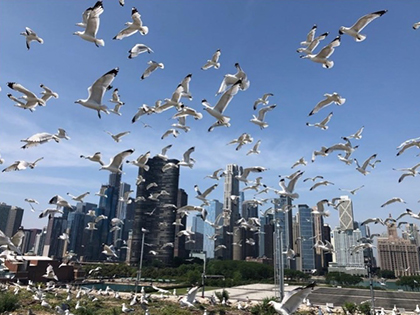The Problem

The largest water treatment plant in the United States is located in Chicago on Lake Michigan. This water treatment plant, which was once the largest capacity water purification plant in the world, currently processes 70% of metro Chicago’s potable water.
The plant consists of 4 buildings, whose roofs stand at varying heights, and are composed of various materials (e.g., asphalt, green, etc.). The roofs have a combined surface area of approximately 998,210 square feet, which is the largest roof surface area in Illinois.
A nesting gull colony, as well as migratory and resident Canada geese, settled on the water treatment plant’s property and caused a number of issues, including:
- Property and asset damage: birds damaged structures, vehicles, and roofs
- Facility health risks: birds increased the presence of organic contaminants and decreased quality of the raw water; to compensate, additional treatment/ chemical feed parameters were used to treat water
- Human health and safety risks: aggressive birds endangered employees and the public, and the accumulation of fecal matter and nesting materials posed additional health threats
Actions
The water treatment plant contracted with Wild Goose Chase (WGC), an environmental services company, to manage their nuisance gull and geese issues through science-based, ecological solutions.
WGC’s staff of experienced animal biologists, structural technicians, and landscape architects designed and implemented an Integrated Pest Management (industry best practice) strategy that combined solutions to address the bird issues in the near- and long-term:
- Trained canine harassment program: trained canines were deployed regularly at various intervals and locations on property to harass nuisance birds
- Population control: nests and eggs were managed to reduce the overall presence of targeted nuisance birds in accordance with state and federal regulations
- Structural deterrents: in-market optical deterrents were implemented and a custom grid system was fabricated to prevent access to certain high-risk areas on the property
- Cleaning: roof surfaces impacted by nuisance birds were commercially cleaned to extend asset life and maintain facility health
- Automated lasers: lasers were installed to cover high risk areas of the property and provide continual harassment to coincide with nuisance bird developmental milestones
Impact
Over a multi-year period, nuisance gull populations were reduced by 93% and nuisance geese populations by 58%. The reduced presence of these nuisance birds had a direct impact on the water treatment plant’s property:
- Reduced property damage: less weight pressure was placed on roofs, and damage to roof membranes was reduced
- Reduced asset damage: vehicle maintenance costs were reduced
- Strengthened facility health: fewer chemicals were needed to compensate for organic contaminants
- Improved human health & safety: employees and the public had significantly less exposure to aggressive birds and the accumulation of fecal matter and nesting materials


